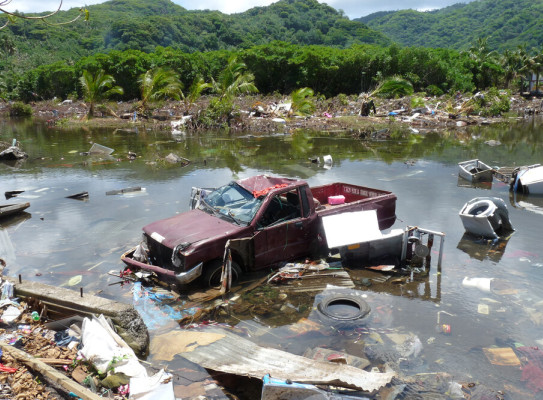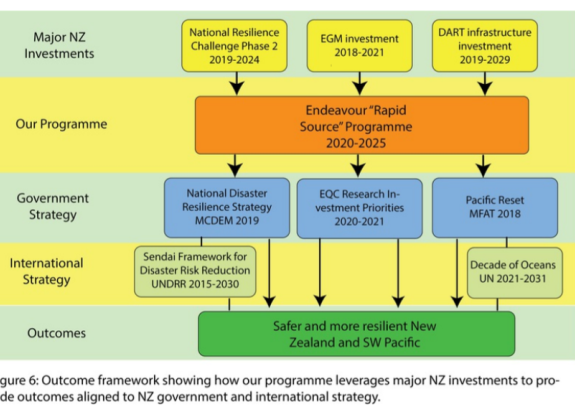
RCETRapid Characterisation of Earthquakes and Tsunami

RCET is developing and deploying state-of-the-art techniques to monitor earthquakes in New Zealand and the Southwest Pacific to assess impacts rapidly and forecast potential damage, including from tsunami.
Overview
For the Rapid Characterisation of Earthquakes and Tsunami (RCET) programme, GNS Science is partnering with iwi, a national network of researchers, local and national government and international organisations.
The project aims to
- Optimise the processing of seismic data immediately after an earthquake to rapidly assess damage and potential impacts
- Create processes to determine if tsunami warnings are necessary
- Develop formal and informal educational resources about natural hazard resilience that interweave Western and indigenous knowledge
To achieve these aims
- We use artificial intelligence (i.e. machine learning) to create rapid tsunami forecasts
- We create new data processing techniques that use both seismic and ocean observation data
- We work with a team of educators to create a variety of resources, including a Youth Hub, lesson plans for teachers and community events
- We work with communities in Northland to incorporate traditional knowledge and to increase resilience to natural hazards, especially earthquakes and tsunami
The project
The need for timely and accurate tsunami warnings
Major earthquakes can occur anywhere around Aotearoa New Zealand. With two thirds of New Zealanders living within 5 km of the coast, all of our coastal communities are vulnerable to tsunami. Following large earthquakes, timely, highly accurate and effective tsunami warnings are key to public safety and confidence. Currently, warnings are broad-scale and often slow, which significantly reduces their effectiveness. Past public confusion around tsunami warnings (e.g. 2016 Kaikoura earthquake and 2019 Kermadecs earthquake) has highlighted problems with this system.
Rapidly characterising earthquakes and tsunami
This programme aims to solve problems of accuracy and speed of tsunami warning delivery. We will develop and adapt a suite of state-of-the-art post-processing techniques, resulting in four-dimensional monitoring of developing earthquakes/tsunami in near real-time. This includes developing geophysical approaches optimised for New Zealand that are based on recent advances in collecting and processing of seismic, geodetic and ocean elevation data, including:
- Regional inversion for earthquake magnitude and mechanism (e.g. W-phase approach elastrogravity inversion)
- Mapping of spatial and temporal dynamics of earthquake rupture (e.g. back-projection of seismic data in a region extending from terrestrial New Zealand to the Tonga-Kermadec Trench)
- Inversion of seismic and DART data for tsunami source and impact models, including inundation early warning
- Artificial intelligence/machine learning approaches to use geodetic, seismic and DART data to rapidly detect events and predict their impacts
The highest performing algorithms will be implemented for operational use in close collaboration with GeoNet. Scientific advances based on real-time analysis will be delivered to central government, the private sector, and the public through formats proven to be successful in the New Zealand and international communities (e.g. USGS National Earthquake information center, Pacific Tsunami Warning Centre, GeoNet).
Community engagement
In partnership with Ngātiwai Education, mātauranga Māori will be woven through the design/geometry of a Northland seismic array. Our engagement with Northland communities underpins Māori and youth engagement with STEM, leveraging the existing education frameworks developed under the University of Auckland Rū programme. STEM curricula will be jointly developed with local teachers to enable secondary school students to participate in network servicing and data management, promoting local end-to-end involvement in the monitoring platform.
By training and supporting students to participate in our research and help disseminate newly gained knowledge to regional communities, our programme supports long-term community development, inspires young New Zealanders to undertake careers in science, and develops stronger ties between Māori, wider communities, and science.
Expected outcomes
The immediate impact of our research is that New Zealand will be better prepared to respond to and recover from major earthquakes and tsunami in NZ and the southwest Pacific. Our research will deliver more timely and accurate scientific advice through 24/7 NGMC to central/local government CDEM agencies and key infrastructure providers in the immediate aftermath.
Our science will add value to investment in ocean and on-land monitoring networks to improve tsunami resilience in both New Zealand and our Pacific neighbours. Pacific partners will be better prepared for regional tsunami and enabled to act on regional forecasts supported by programme outcomes and ongoing collaborations (UNESCO-IOC).
Through local community and student engagement, Māori partners and the Northland community will have greater awareness and preparedness for earthquake and tsunami events. We also hope our engagement will lead to an increased number of Māori youth considering STEM careers.

-
Publications
Chamberlain, C.J., Frank, W., Lanza, F., Townend, J and Warren-Smith, E. 2021. Illuminating the pre-, co-, and post-seismic phases of the 2016 M7.8 Kaikoura earthquake with 10 years of seismicity. Journal of Geophysical Research: Solid Earth. DOI: 10.1029/2021JB022304.
Mochizuki, K.; Henrys, S.A.; Haijima, D.; Warren-Smith, E.; Fry, B. 2021 Seismicity and velocity structure in the vicinity of repeating slow slip earthquakes, northern Hikurangi subduction zone, New Zealand. Earth and Planetary Science Letters, 563: article 116887; doi: 10.1016/j.epsl.2021.116887
Yao, D.; Peng, Z.; Kaneko, Y.; Fry, B.; Meng, X. 2021 Dynamic triggering of earthquakes in the North Island of New Zealand following the 2016 Mw 7.8 Kaikoura earthquake. Earth and Planetary Science Letters, 557: article 116723; doi: 10.1016/j.epsl.2020.116723
Yin, Y.; Wiemer, S.; Kissling, E.; Lanza, F.; Fry, B. 2021 Seismicity rate change as a tool to investigate delayed and remote triggering of the 2010–2011 Canterbury earthquake sequence, New Zealand. Bulletin of the Seismological Society of America, Online first: doi: 10.1785/0120210006

Research project details
Collaborators: GNS Science, NIWA, University of Canterbury, Victoria University of Wellington, University of Otago, Geoscience Australia, University of Oregon, Australian National University, University of Washington, Ngātiwai Education, University of Auckland, NOAA USGS, PTWSNEMA, CDEM groups, MFAT, Transpower, Bay of Plenty Regional Council, Port of Tauranga, Kiwi North (Whangarei Museum), Rū Seisometers in School programme
Duration
2021–2026
Funding platform
Endeavour Fund
Status
Current
Programme leader
Bill Fry
Funder
MBIE